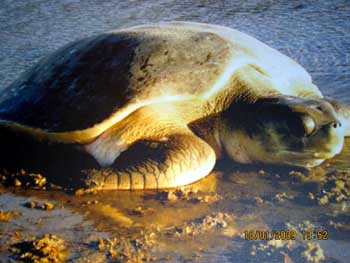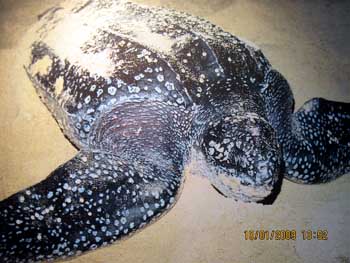Turtles are the oldest living group of reptiles. An exhibition on these creatures was held in the Egmore Museum recently.  Real specimens of turtles were kept in glass cases. One was that of a large Loggerhead turtle which was kept in front of a large picture of the sea and covered all around in sand. Two more Loggerhead turtles were kept in glass cases in the middle of the room.
Real specimens of turtles were kept in glass cases. One was that of a large Loggerhead turtle which was kept in front of a large picture of the sea and covered all around in sand. Two more Loggerhead turtles were kept in glass cases in the middle of the room.
Some 200 million years ago, the fertilized remains of the first recognizable turtle was found in rocks. Having traveled the seas for over 100 million years these turtles have outlived almost all the other prehistoric animals with which they once shared the planet. Archelon is the largest known turtle that ever lived, measuring up to 11 feet long and 12 feet across the flippers.
Even the real shell of a Hawksbill turtle was displayed at the exhibition. Its shell is heart shaped and resembles the cheetah skin a lot. It’s named so because of its narrow head and large pointed beak which makes it look like a hawk and its shell was used long ago to make things like combs, boxes, etc.
 The pictures of the different varieties of turtles were stuck on the walls next to sheets of paper which gave us information about the respective turtles.
The pictures of the different varieties of turtles were stuck on the walls next to sheets of paper which gave us information about the respective turtles.
The Leatherback turtle is different from the others as its shell is made of a layer of thin, tough, rubbery skin which looks like leather because of which it was named so. The leather back turtles are also able to hold oxygen in blood and body tissues whereas the other turtles store oxygen only in their lungs.
The Flatback turtle is unusual because it lays fewer but larger eggs that the other turtles. The females emerge onto the beach on which they hatched more than 30 years ago and make their way up the beach to lay their eggs.
The Loggerhead turtles have been sighted in the Indian Ocean, along the eastern coast and near the Andaman and Nicobar Islands.
Arribada, a Spanish term meaning ‘arrival; a mass nesting behavior’, is a unique nesting phenomenon common to both the Olive Ridley turtle and the Kemp’s Ridley sea turtle. In India, Arribada takes place along the Orissa coast.
 Where the turtles go and what reunites them for nesting is still a mystery. So, many countries fit satellite tracked transmitters on the turtles’ backs to study abut the migrating of turtles.
Where the turtles go and what reunites them for nesting is still a mystery. So, many countries fit satellite tracked transmitters on the turtles’ backs to study abut the migrating of turtles.
The turtles are critically endangered now because of many factors which affect them such as habitat destruction, hunting and egg collection, entanglement in fishing gear, climate change and pollution.
Many turtles die as they accidentally enter into a trawler’s net and unable to surface for air, these turtles can drown in 40 minutes. As a result of this, many countries have insisted upon the usage of Turtle Excluder Devices (TED), which will allow the turtles to escape even if they enter into the net.
Turtles are very extraordinary creatures and very precious to the earth. So let us stop hunting them and conserve them as they have also joined the group of endangered animals.
